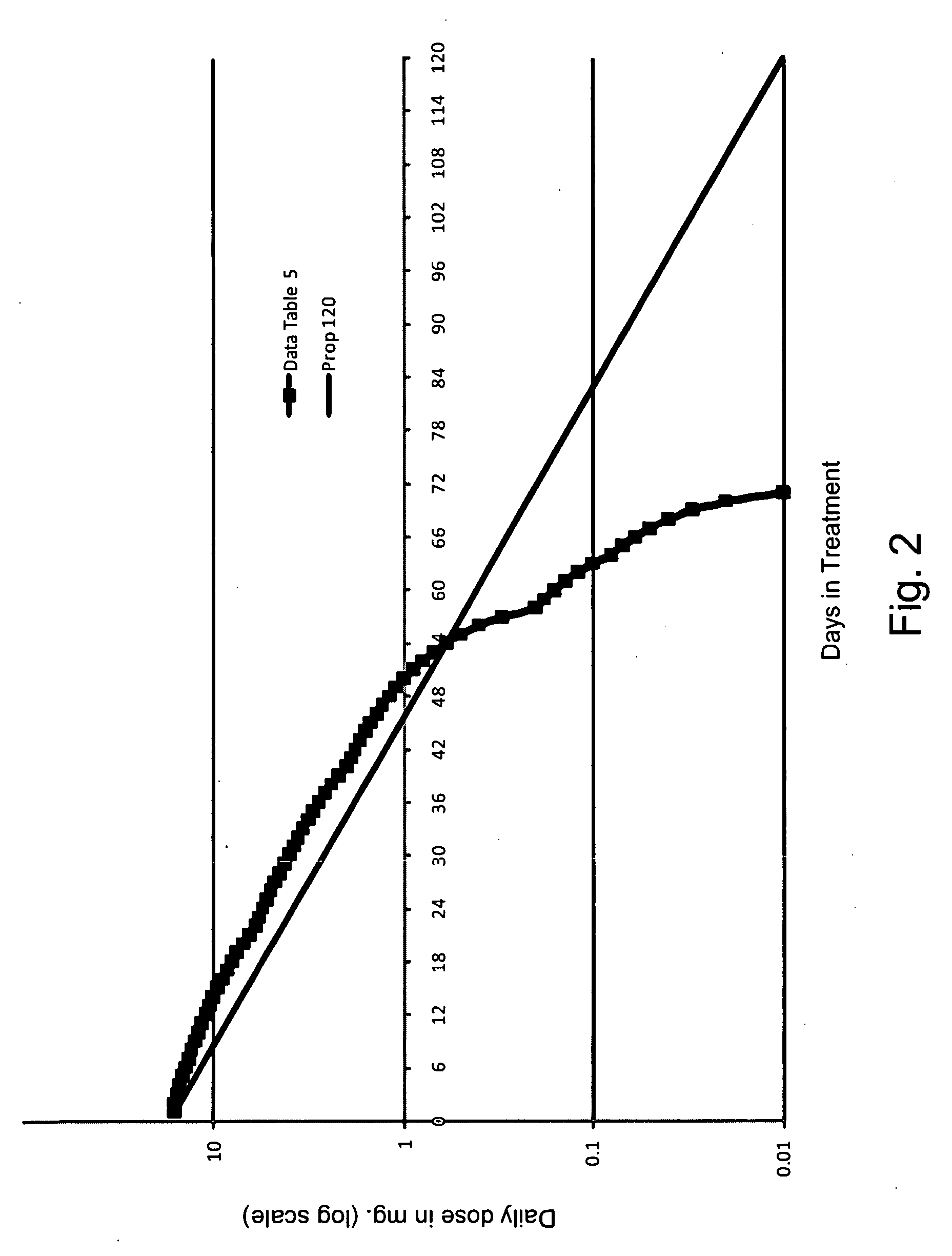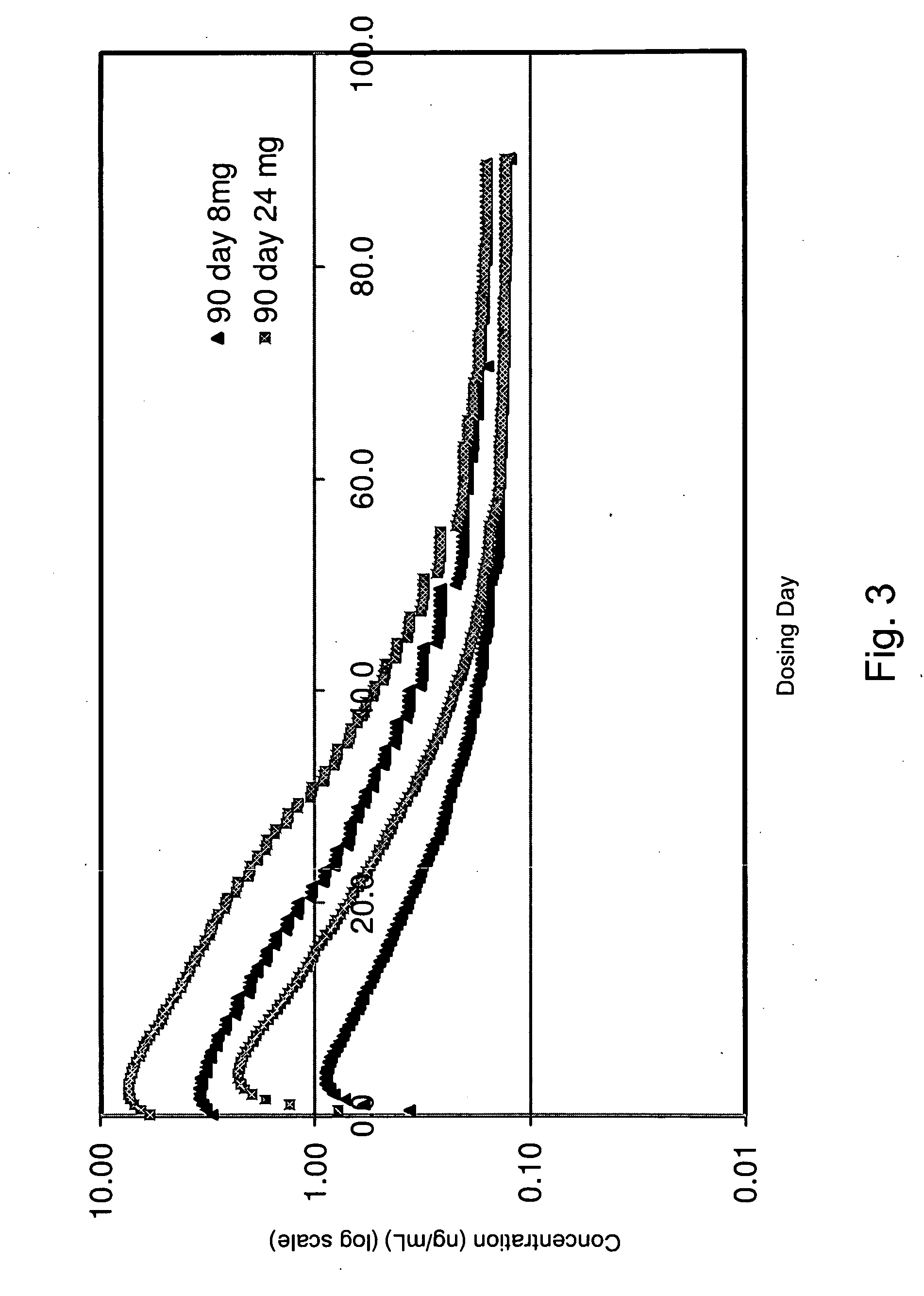Method and dosage regimens for eliminating a chemical substance in blood
- Summary
- Abstract
- Description
- Claims
- Application Information
AI Technical Summary
Benefits of technology
Problems solved by technology
Method used
Image
Examples
example 1
[0077]This patient began treatment with being administered a dosage of 6.0 mg of buprenorphine daily, via four lozenges. From there, the dosage of buprenorphine decreased daily by 0.5 mg, until the dosage was 2.0 mg. From there the patient's dosage was decreased 0.2 mg a day until the dosage was 1.0 mg. At that point, the dosage was reduced by 0.1 mg a day and the dosage of 0.2 mg was given for two days. When the patient reached a dosage of 0.1 mg, the dosage was then dropped to 0.05 mg, however, due to the patient suffering from withdrawal symptoms, the dosage was increased to 0.1 mg, which was administered for three days. At which point the dosage was again decreased to 0.05 mg a day for two days. The dosage was then decreased to 0.03 mg, then to 0.01 mg of the last day of treatment with buprenorphine.
[0078]The patient was then given a 1.0 mg dosage of Quinine. On the last day the patient was given a 100 mg dosage of Seroquel®. A summary of the dosage can be seen in Table 1 below:...
example 2
[0079]This patient began treatment with being administered a dosage of 6.0 mg of buprenorphine daily, via nine lozenges. From there the dosage of buprenorphine decreased daily by 0.25 mg, until the dosage was 2.0 mg. From there, the patient's dosage was decreased 0.2 mg a day until the dosage was 1.0 mg. At that point, the dosage was reduced by 0.1 mg a day. When the patient reached a dosage of 0.1 mg, the dosage was then dropped to 0.05 mg, the dosage was then 0.03 mg, and finally 0.01 mg on the final day of treatment with of buprenorphine.
[0080]The patient was then given a 1.0 mg dosage of Quinine for two days. On the last day the patient was given a 0.5 mg dosage of naltrexone. A summary of the dosage can be seen in Table 2 below:
TABLE 2Pre-Dos-No. ofscriptionageLoz-No.Medication(mg)engesDirections / Frequency9013Buprenorphine6.009Take 1 Troche sublinguallyTrocheFour Times Daily9014Buprenorphine5.759Take 1 Troche sublinguallyTrocheFour Times Daily9015Buprenorphine5.509Take 1 Troche...
example 3
[0081]This patient began treatment with being administered a dosage of 7.5 mg of buprenorphine daily, via four lozenges. From there the dosage of buprenorphine decreased daily by 0.5 mg, until the dosage was 2.0 mg. From there, the patient's dosage was decreased 0.2 mg a day until the dosage was 1.0 mg. At that point, the dosage was reduced by 0.1 mg a day. When the patient reached a dosage of 0.1 mg, the dosage was then dropped by 0.02 mg each day until finally the dosage was mg on the final day of treatment with of buprenorphine.
[0082]The patient was then given a 1.0 mg dosage of Quinine for four days. On the last day the patient was given a 0.5 mg dosage of naltrexone. A summary of the dosage can be seen in Table 3 below:
TABLE 3DosageNo. ofPrescription No.Medication(mg)LozengesDirections / Frequency8892Buprenorphine7.504Take 1 Troche sublinguallyTrocheTwice Daily8893Buprenorphine7.004Take 1 Troche sublinguallyTrocheTwice Daily8894Buprenorphine6.504Take 1 Troche sublinguallyTrocheTw...
PUM
| Property | Measurement | Unit |
|---|---|---|
| Fraction | aaaaa | aaaaa |
| Time | aaaaa | aaaaa |
| Time | aaaaa | aaaaa |
Abstract
Description
Claims
Application Information
 Login to View More
Login to View More - R&D
- Intellectual Property
- Life Sciences
- Materials
- Tech Scout
- Unparalleled Data Quality
- Higher Quality Content
- 60% Fewer Hallucinations
Browse by: Latest US Patents, China's latest patents, Technical Efficacy Thesaurus, Application Domain, Technology Topic, Popular Technical Reports.
© 2025 PatSnap. All rights reserved.Legal|Privacy policy|Modern Slavery Act Transparency Statement|Sitemap|About US| Contact US: help@patsnap.com



